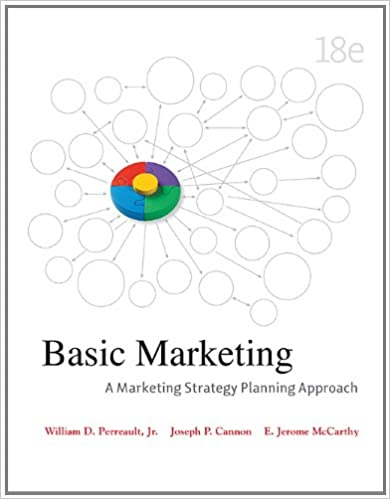
BASIC MARKETING 18th Edition by Jerome McCarthy William Perreault, Joseph Cannon
Edition 18ISBN: 978-0077577193
BASIC MARKETING 18th Edition by Jerome McCarthy William Perreault, Joseph Cannon
Edition 18ISBN: 978-0077577193 Exercise 3
VENDOR ANALYSIS
CompuTech, Inc., makes circuit boards for microcomputers. It is evaluating two possible suppliers of electronic memory chips.
The chips do the same job. Although manufacturing quality has been improving, some chips are always defective. Both suppliers will replace defective chips. But the only practical way to test for a defective chip is to assemble a circuit board and "burn it in"-run it and see if it works. When one chip on a board is defective at that point, it costs $2.00 for the extra labor time to replace it. Supplier 1 guarantees a chip failure rate of not more than 1 per 100 (that is, a defect rate of 1 percent). The second supplier's 2 percent defective rate is higher, but its price is lower.
Supplier 1 has been able to improve its quality because it uses a heavier plastic case to hold the chip. The only disadvantage of the heavier case is that it requires CompuTech to use a connector that is somewhat more expensive.
Transportation costs are added to the price quoted by either supplier, but Supplier 2 is further away so transportation costs are higher. And because of the distance, delays in supplies reaching CompuTech are sometimes a problem. To ensure that a sufficient supply is on hand to keep production going, CompuTech must maintain a backup inventory-and this increases inventory costs. CompuTech figures inventory costs-the expenses of finance and storage-as a percentage of the total order cost.
To make its vendor analysis easier, CompuTech's purchasing agent has entered data about the two suppliers on a spreadsheet. He based his estimates on the quantity he thinks he will need over a full year.
a. Based on the results shown in the initial spreadsheet, which supplier do you think CompuTech should select? Why?
b. CompuTech estimates it will need 100,000 chips a year if sales go as expected. But if sales are slow, fewer chips will be needed. This isn't an issue with Supplier 2; its price is the same at any quantity. However, Supplier 1's price per chip will be $1.95 if CompuTech buys less than 90,000 during the year. If CompuTech only needs 84,500 chips, which supplier would be more economical? Why?
c. If the actual purchase quantity will be 84,500 and Supplier 1's price is $1.95, what is the highest price at which Supplier 2 will still be the lower-cost vendor for CompuTech? (Hint: You can enter various prices for Supplier 2 in the spreadsheet-or use the analysis feature to vary Supplier 2's price and display the total costs for both vendors.)
CompuTech, Inc., makes circuit boards for microcomputers. It is evaluating two possible suppliers of electronic memory chips.
The chips do the same job. Although manufacturing quality has been improving, some chips are always defective. Both suppliers will replace defective chips. But the only practical way to test for a defective chip is to assemble a circuit board and "burn it in"-run it and see if it works. When one chip on a board is defective at that point, it costs $2.00 for the extra labor time to replace it. Supplier 1 guarantees a chip failure rate of not more than 1 per 100 (that is, a defect rate of 1 percent). The second supplier's 2 percent defective rate is higher, but its price is lower.
Supplier 1 has been able to improve its quality because it uses a heavier plastic case to hold the chip. The only disadvantage of the heavier case is that it requires CompuTech to use a connector that is somewhat more expensive.
Transportation costs are added to the price quoted by either supplier, but Supplier 2 is further away so transportation costs are higher. And because of the distance, delays in supplies reaching CompuTech are sometimes a problem. To ensure that a sufficient supply is on hand to keep production going, CompuTech must maintain a backup inventory-and this increases inventory costs. CompuTech figures inventory costs-the expenses of finance and storage-as a percentage of the total order cost.
To make its vendor analysis easier, CompuTech's purchasing agent has entered data about the two suppliers on a spreadsheet. He based his estimates on the quantity he thinks he will need over a full year.
a. Based on the results shown in the initial spreadsheet, which supplier do you think CompuTech should select? Why?
b. CompuTech estimates it will need 100,000 chips a year if sales go as expected. But if sales are slow, fewer chips will be needed. This isn't an issue with Supplier 2; its price is the same at any quantity. However, Supplier 1's price per chip will be $1.95 if CompuTech buys less than 90,000 during the year. If CompuTech only needs 84,500 chips, which supplier would be more economical? Why?
c. If the actual purchase quantity will be 84,500 and Supplier 1's price is $1.95, what is the highest price at which Supplier 2 will still be the lower-cost vendor for CompuTech? (Hint: You can enter various prices for Supplier 2 in the spreadsheet-or use the analysis feature to vary Supplier 2's price and display the total costs for both vendors.)
Explanation
Case brief: A vendor analysis is borne o...
BASIC MARKETING 18th Edition by Jerome McCarthy William Perreault, Joseph Cannon
Why don’t you like this exercise?
Other Minimum 8 character and maximum 255 character
Character 255


